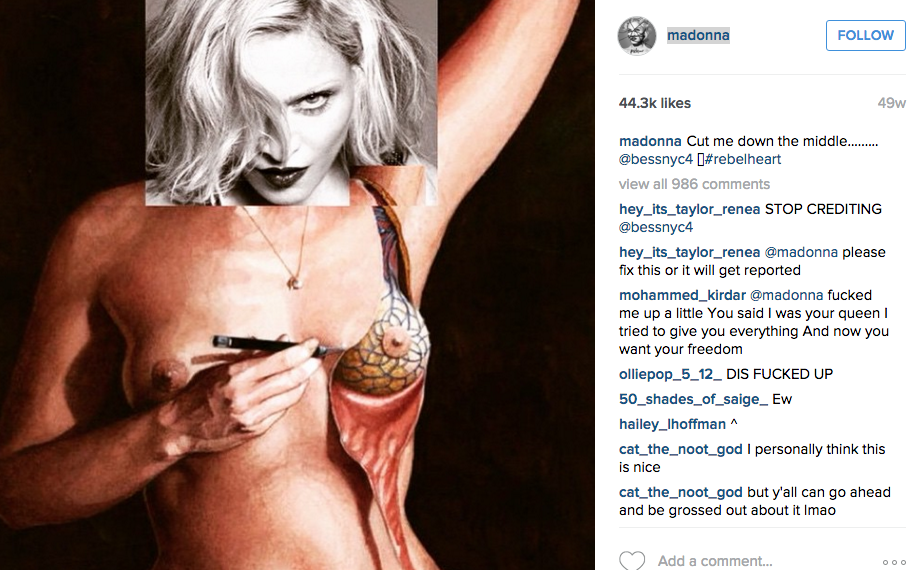Artists on Reddit are mad at Madge. “Madonna has been shameless pasting her face on the artwork of unknown artists without credit or permission,” reads a thread on the Music subreddit that’s been gaining traction since Sunday. Danny Quirk of Springfield, Mass., is at the center of the claims against the queen of pop: In a Facebook post on Saturday, the painter came after Madonna for using a version of his works on social media and in her live shows without giving Quirk credit or compensation.
The images in question feature a photo of Madonna’s face pasted over Quirk’s realistic paintings of people opening their insides to the world. DIYPhotography reports that the works were part of a series, “Dissections,” done for a senior project at the Pratt Institute. Quirk says he contacted Madonna’s agent when he saw that she was posting material that used his work earlier this year, but received no response. When he found out she was using the images on her concert tour, he got a lawyer—who told him the images were modified enough to be considered fair use, not copyright infringement.
“I just want to deliver an open, and honest ‘FU¢K YOU’ to the ‘Fair Use Act’, and an ACTUAL ‘what the FUK!?!?’ to those it protects,” Quirk wrote on Facebook.
In this case, fair use law is protecting former New York City boutique owner Doug Abraham, aka BessNYC4, whose works are mainly collages that pull from celebrity likenesses and high-fashion ads. Abraham didn’t take the photo of Madonna in the images, either; he just mashed up the two works. Artists have a lot of leeway when it comes to using others’ creative output in their works. One of the most famous art-world beneficiaries of the fair-use doctrine is Richard Prince, whose blown-up photos from other artists’ Instagram accounts have sold for up to $100,000. Prince caused a hubbub in the art market in 2011, when he made collages with images from a Patrick Cariou photobook and made millions. The U.S. Court of Appeals ruled that Prince’s modifications were fair use.
Is Abraham’s art legal? Yes, most likely. Is it ethical? Not really. “Other brands could spend all of this money and time making these images and I could do my thing and get it out to people immediately,” Abraham told i-D of his appropriation of fashion advertisements. “I can steal your picture and make it into my picture.” Quirk isn’t a brand, though, and he isn’t funding his images with a corporate ad budget. He’s a fresh-out-of-school artist trying to make his name in the art world. When Abraham “steals” images from Christian Dior and Givenchy, he’s not doing them much harm; in fact, by keeping their logos in his images, he might be doing them a solid. When he uses Quirk’s paintings without giving him a shout-out in the caption, Abraham is punching down.
Whoever runs Madonna’s social media feeds credited BessNYC4 on her posts, which is more than Taylor Swift’s social media minions did when they posted what appeared to be a fan-art tracing of a New Orleans artist’s fox illustration on Swift’s accounts. Abraham didn’t include Quirk’s name in his original posts, but Madonna’s people should have had the wherewithal to track the image and give Quirk a credit, too. Artists who are successful enough to have a team of PR experts at their disposal have more than enough resources to vet the images they use on their social accounts and in their concert visuals, which are vital parts of their brand-shaping—and thus their money-making—strategies. In the era of Google Image Search, the origins of most post-modern artworks are easy enough to trace. When you’ve already earned millions of dollars and social-media followers, it’s a small price to pay for a cool post.
